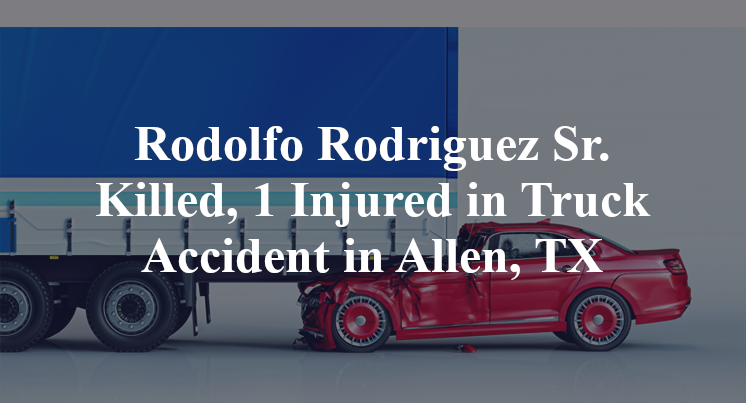Rodolfo Rodriguez Sr. Killed, 1 Injured in Truck Accident in Allen, TX
Allen, TX — June 29, 2025, Rodolfo Rodriguez Sr. was killed and another person was injured in a truck accident at approximately 7:00 a.m. along U.S. 75.
According to authorities, 52-year-old Rodolfo Rodriguez Sr., of Garland, and at least one other person were traveling in a Chevrolet Malibu on U.S. 75 in the vicinity of Bethany Drive when the accident took place.

Officials indicate that, for as yet unknown reasons, the Malibu left it's lane and entered the right shoulder of the highway. There, it reportedly collided with the rear-end of an 18-wheeler that had been parked there with its hazard lights activated.
Rodriguez was apparently entrapped in the wreckage and had to be extricated by emergency personnel. Once freed from the aftermath, however, he was declared deceased due to the injuries he incurred in the accident.
One other person who had been a passenger in the Malibu sustained injuries of unknown severity, as well, though they were described as to have been non-life-threatening; they were transported to a local medical facility by EMS in order to receive necessary treatment.
Additional details pertaining to this incident are not available at this point in time. The investigation is currently ongoing.
Commentary
When a passenger vehicle strikes the back of a parked 18-wheeler on the shoulder, most people assume it's just a case of driver error. But those assumptions can short-circuit a full investigation—one that should explore not only what the driver of the car was doing, but whether the truck should have been there in the first place, and if so, whether it was parked as safely as possible under the law.
Just because a truck has its hazard lights on doesn’t automatically mean it's parked legally or safely. The shoulder of a highway isn’t a rest stop—it’s typically reserved for emergencies. If the 18-wheeler was pulled over for a mechanical issue or a health event, that might explain its presence. But if it was parked there without a valid emergency—say, for convenience, to check directions, or make a call—then that opens the door to questions about whether it was creating an unnecessary hazard.
There’s also the issue of visibility. Commercial drivers are trained to set up warning devices—reflective triangles or flares—when they stop on a shoulder for any length of time. That’s not optional. It’s a federal requirement. If those weren’t deployed, or weren’t spaced correctly, then it’s possible that the Malibu’s driver didn’t have enough advance warning to react appropriately. I’ve seen that exact scenario play out in cases where a driver never saw a stopped truck until it was too late—not because they weren’t looking, but because the required warnings weren’t there.
At the same time, the key question remains: why did the Malibu drift onto the shoulder? That’s not normal driving behavior, and it will be critical to understand whether distraction, fatigue, impairment, or a mechanical problem played a role. Event data from the vehicle, dash cam footage (if any), and phone records may offer answers.
But none of these factors should be examined in isolation. In my experience, these kinds of crashes often involve shared responsibility. One party’s mistake creates the risk; another’s compounds it. That’s why a real investigation has to dig deeper than first impressions. It’s not just about who hit whom—it’s about why the situation existed in the first place.
Key Takeaways
- It's unclear why the Malibu left its lane and entered the shoulder; that will be a central focus of the investigation.
- Whether the 18-wheeler was parked legally and for a valid reason is a critical question.
- Trucking regulations require visible warning devices when parked on the shoulder—failure to comply could factor into liability.
- Vehicle data, cell phone records, and mechanical inspections will all play a role in understanding what led to the collision.
- Determining accountability depends on a full reconstruction of all contributing factors—not just the final impact.

“These are essential reads for anyone dealing with the aftermath of a truck wreck”– Attorney Cory Carlson